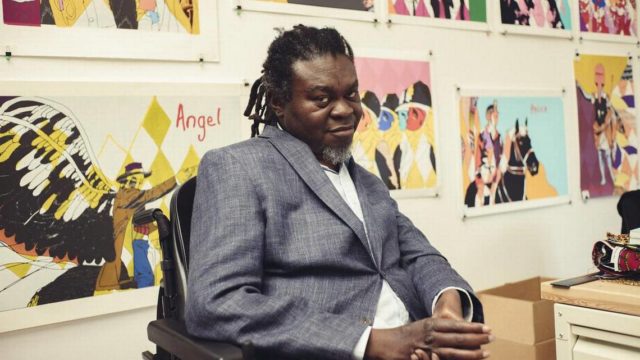Written by Lisa Rab, arts correspondent for the Charlotte Observer.
In his quest to capture the shape of wind, Yinka Shonibare started with a hair dryer and a piece of fabric. The British-Nigerian artist sees movement as a metaphor for the migration of people – immigrants, slaves, refugees. He wanted his fiberglass sculpture to convey that movement while appearing weightless, as if it were defying gravity. So he photographed the fabric billowing in the dryer’s artificial breeze. That photo became a mold, which he converted into a 3D image, and then a 3D print. That grew into a larger mold, stretching to 23 feet high. Shonibare worked with a team of assistants to shape the fiberglass and paint it shades of orange and turquoise, meant to resemble the fabric often worn by women in West Africa.
The end product was enormous, vivid, and confounding. “It’s sculpture trying to sculpt the impossible,” Shonibare said by phone from his London studio.
“Wind Sculpture SG (I)” was commissioned by the Public Art Fund to debut in New York City’s Central Park in March. But its unusual journey did not end there. In mid-November, the towering piece of public art finds a permanent home on the campus of Davidson College (a public dedication will be at 4:30 p.m. Nov. 14, on site). It’s part of the college’s growing sculpture garden and Davidson’s efforts to diversify its campus artwork. “It shows the kinds of monuments we can create,” said Lia Newman, director and curator of the Van Every/Smith Galleries at Davidson.
Shonibare is a renowned artist whose sculptures have appeared in London’s Trafalgar Square and at the Smithsonian National Museum of African Art. He often addresses the legacy of colonialism in his work, challenging conventional notions about the divisions between cultures and countries. Those themes resonated with Davidson officials. Last September, the college created a Commission on Race and Slavery – to be led by former Charlotte mayor Anthony Foxx – charged with examining how Davidson’s history “is intertwined with the institution and legacies of slavery and the lives of enslaved persons,” college president Carol Quillen wrote in a statement last fall.
Newman had followed Shonibare’s work since the mid-1990s, and thought his sculptures provided a new way to think about public art. Instead of building a monument to a flawed person – such as the Confederate statues that have sparked controversy on other university campuses – “Wind Sculpture” is more abstract, but “can still interrogate difficult subjects,” she said.
Shonibare’s series of wind sculptures evolved from another monumental work he created for Trafalgar Square, “Nelson’s Ship in a Bottle.” Admiral Lord Nelson’s victory against Napoleon in the 1805 Battle of Trafalgar led to the expansion of the British Empire. In his version of Nelson’s ship, Shonibare constructed 37 sails from brightly patterned Dutch batik fabric, which appears to be billowing in the wind.
Shonibare frequently uses this fabric in his work because of the many layers of meaning it conveys. The colorful cloth was originally manufactured in Europe in the 19th century, designed to mimic handmade, Indonesian fabric. But when buyers in Indonesia rejected it, the printed fabric was marketed in the colonies of West Africa, where it later became a popular symbol of pride and independence. It’s now commonly associated with Africa, despite its colonial origins.
Shonibare, who was born in London and raised in Nigeria, enjoys upending assumptions about race and class in his work. He embraces his multinational identity and cautions against the nationalism that’s now on the rise in America and Europe. “You don’t have to be nationalistic in your approach,” he said. “That could lead to excluding a lot of people, which could then lead to a lot of hate. And historically we know that that has actually ended up in disaster.”
The gallery exhibition is open to the public through Dec. 14. Shonibare plans to visit the campus Nov. 13-15 to dedicate the sculpture, speak to students and participate in a public discussion with Carol Quillen.
“I’d like them to be awed by the sculpture,” he said of his work. “I’d like them to be blown away by it. I’d like them to enjoy it and also, possibly, think about it.”
This story is part of an Observer underwriting project with the Thrive Campaign for the Arts, supporting arts journalism in Charlotte. Lisa Rab is a journalist in western North Carolina whose work has appeared in Harper’s and The Washington Post Magazine. Reach her at lisarab.com.
Read the original article from the Charlotte Observer here

